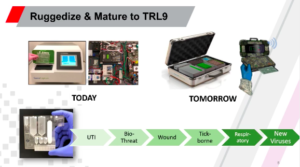
Army acquisition chief Bruce Jette presides over an earlier Expeditionary Technology Search contest.
WASHINGTON: This week, small-business innovators will go online for a virtual “shark tank” meeting with Army experts, pitching ideas for low-cost, low-maintenance ventilators. Successful pitches get $100,000 to develop their ideas and, if they perform, a shot at a production contract.
But can one of the world’s most notoriously slow, hidebound bureaucracies actually deliver ventilators in time to help fight COVID-19, the pandemic coronavirus that’s already overloading hospitals in hotspots like New York? Well, yes and no.

GeneCapture got Army xTechSearch funding to help turn its microwave-sized scanner into a portable unit capable of testing for 200 diseases in 60 minutes.
The military can move faster than you think, as it proved with rapid fielding of counter-IED technology, quick-clotting kits for wounds, and other gear to reduce deaths in Afghanistan and Iraq. The Army’s annual xTechSearch competition has already turned up some technologies potentially applicable to coronavirus, like a rapid identification test for pathogens.
Second, presidential optimism notwithstanding, COVID-19 is likely to linger, and perhaps even start a second outbreak, both in the United States and abroad. That threat’s especially acute in poor countries and austere US outposts, where there’s a huge need for a cheap, rugged ventilator that doesn’t require a stable electrical supply or bottled oxygen.
“This competition is not looking for the Cadillac of ventilators,” said Matt Willis, a PhD chemical engineer who worked on defenses against poison gas at the Army’s Edgewood, Md. Chemical-Biological Center before moving to DC to serve as the service’s director for laboratory management. “We’re looking for something that be delivered quickly, of course delivered safely – we’re not circumventing the FDA… and can operate in these more austere environments that don’t necessarily have clean power or hospital-grade oxygen.”

Matt Willis
But the Army doesn’t imagine it can start mass-producing a new design in time to save patients in extremis today, or even next month, when at least some medicals predict the caseload – and with it, the death toll – will peak across much of the country.
“We recognize that the peak could be in a matter of weeks,” Willis told me. “[But] while the peak might be coming soon, we need to prepare for the next wave of cases that might happen either domestically or internationally. We have troops stationed across the globe and we need to be ready to support allied nations, [so] this need, particularly for ventilators, is not going to go away.”
Yes, the timeline is a “challenge,” Willis said. “How fast can we really get it done? Under normal times, this would take several months, minimally.” But these are far from normal times.
“For very good reasons… the traditional medical acquisition and the regulatory approval process is often seen as a very deliberate process, which some might say just is slow,” said Col. Matt Clark. He’s a medical technologist – like Willis, versed in chemical and biological defense – who’s now the Army’s acquisition director for medical systems. But during the COVID-19 crisis, he explained, “the FDA is leaning forward quite heavily,” offering an urgent approval process that the Army will use here.
What’s more, Clark said, the fundamental medical principles are almost a century old, dating back to the first iron lung to save a life from polio in 1928. Since then, of course, better understanding of human respiration, superior materials, and miniaturized electronics have made ventilators much smaller and more manageable. But, unlike with a new vaccine or antiviral drug, which may not work at all, no one has to prove that pumping oxygen into damaged lungs saves lives.

Col. Matthew Clark
What the Army’s trying to improve is how you pump the oxygen. With modern materials science, computer-aided design, and 3D printing, Clark told me, “I think there’s opportunity to do this in a way that can be readily manufactured [and] affordable, with minimal components.”
Of course, if the Army already knew exactly what to build, they’d be building it already. But since the Army is increasingly aware that most of the nation’s most innovative minds don’t work for the Defense Department or defense contractors, it created the xTechSearch competition to encourage small companies with little or no experience dealing with the military to bring forward new ideas.
Now, the normal xTechSearch process is fast, at least by Army standards, but it still takes months to solicit, review, and judge the entries over multiple rounds. That’s too slow for the coronavirus pandemic. So the Army’s spun off an accelerated “COVID-19 Ventilator Challenge.” Instead of a set submission deadline and award date, there’s a rolling application. A panel of both government and independent experts will review each submission as it comes in. If an idea rates high enough, they can award a prize immediately. The Army’s using a special authority that lets them wire money to a winner’s account, Willis said, “in a matter of hours, a couple days maximum.”
- Starting last Thursday, all comers are welcome to submit ideas online. To keep things simple for both applicants and reviewers, submissions must consist of a single slide and a video of no more than three minutes explaining the idea or, better yet, demonstrating a prototype in action.
- If your submission intrigues the evaluators, you get a $5,000 prize and an appointment to make an online pitch with a week. The first pitch session could be as early as April 13, today.
- If your pitch impresses, you get a $100,000 prize to work on your technology, with formal Army contracts potentially in the offing.
The Ventilator Challenge currently has a million dollars in government funding, enough to give 20 entrants $5,000 prizes and nine of those 20 $100,000 awards. But if more than 20 ideas look promising, the Army is willing to invest more.
Move over FARA: General Atomics pitching new Gray Eagle version for armed scout mission
General Atomics will also showcase its Mojave demonstrator for the first time during the Army Aviation Association of America conference in Denver, a company spokesman said.


























